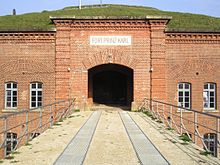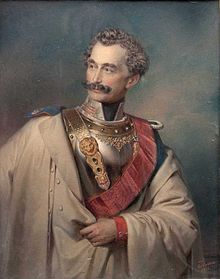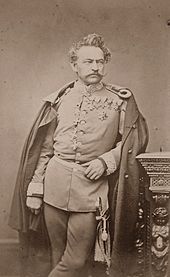Karl of Bavaria



Karl Theodor Maximilian August Prince of Bavaria (born July 7, 1795 in Mannheim , † August 16, 1875 in Tegernsee ) was Field Marshal General and Imperial Councilor of the Crown of Bavaria . He was Commander-in-Chief of the Bavarian Army and the remaining southern German contingents of the Federal Army (so-called West German Army) in the German War of 1866 .
Life
Prince Karl was born as the younger son of the later first Bavarian King Maximilian I Joseph and Auguste Wilhelmine (1765–1796), daughter of Landgrave Georg Wilhelm von Hessen-Darmstadt . His older brother was the subsequent King Ludwig Karl August (1786–1868). From 1808 to 1813 Count Anton von Rechberg (1776–1837) was his tutor, who in 1816 again took over the office of personal chief court master . He was instructed in history and literature by Hofrat Karl Wilhelm Friedrich von Breyer .
The prince received a mainly military education. On June 25, 1813, Prince Karl was promoted to major general and participated as a brigadier in the wars of liberation against France. In the campaign of 1814 he fought under General von Wrede in the battles of Brienne and Arcis-sur-Aube , in the latter his brigade stormed the village of Torcy-le-Grand on March 20th .
In 1813 he was made an honorary member of the Bavarian Academy of Sciences .
Because of his first morganatic marriage in 1823 with Marie-Anne-Sophie Petin (1796-1838), who then received the title Countess von Bayrstorff, Prince Karl lost his claim to the Bavarian throne. From this marriage there were three daughters:
- Caroline Sophie (* October 16, 1817; † May 25, 1889) ∞ Adolf Eberhard von Gumppenberg (* February 24, 1804; † December 16, 1877)
- Maximiliane Theodore (* September 20, 1823; † March 19, 1895) ∞ August Wilhelm Drechsel on Deufstetten (* March 28, 1810; † May 20, 1880)
- Franziska Sophie (October 10, 1827 - March 2, 1912) ∞ Paulo Martins de Almeida (June 18, 1807 - April 7, 1874), 1st Vice-Count of Almeida
His second marriage to Henriette Schoeller von Frankenburg remained childless. In the Brienner Street in Munich that exists Palais Bayrstorff-Almeida , who in 1824 built residence of Prince Charles' wife.
He turned down the Greek royal crown offered to him in 1831, after which it went to his nephew, Prince Otto . On January 16, 1841, Karl was appointed field marshal and inspector of the Bavarian army . After King Ludwig's reputation among the people and especially among the Munich population had been seriously damaged by the affair with Lola Montez and the news of the revolution arrived in Paris , the rallies in Munich, Augsburg and Nuremberg never stopped. On March 3, 1848, thousands of citizens signed a petition in Munich's town hall calling for further reforms and civil liberties, and when demonstrators stormed the armory in Munich on March 4, 1848 armed themselves, it was Prince Karl, the king's brother and field marshal of the Bavarian Army, ensured calm by his appearance. In 1860 he became Commander-in-Chief of the Seventh German Federal Army Corps .
Role in the German war
Prince Karl v. a. during the German War of 1866 as Commander-in-Chief of the Bavarian Army and the other southern German federal contingents (so-called West German Army) in the war against Prussia. On May 21, 1866, the prince took command of the West German Federal Army and General von der Tann was appointed Chief of Staff. After the Pyrrhic victory of the Hanoverians near Langensalza on June 27th, the attempt was made to establish a connection with them, but the following day the report of the capitulation of George V arrived. The Bavarians were now looking to join the VIII Federal Corps under Prince Alexander of Hesse . On July 3, the defeat of the Austrians at Königgrätz became known, the VIII. Federal Corps therefore saw its main task in covering the Main line at Frankfurt. The Prussian Main Army under the command of General Vogel von Falckenstein advanced with about 54,000 men against the Saale valley.
On July 10, the Bavarians were defeated under Prince Karl near Kissingen near Garitz and Hammelburg. The Prussian Main Army tried to prevent the federal troops from uniting. The Prussians therefore advanced via the Taubertal, with the VIII Federal Corps fighting at Hundheim and Tauberbischofsheim . Meanwhile, the Bavarians withdrew towards Würzburg . On July 25th and 26th, the Bavarians were pushed back again in the final battles around Uettingen and Roßbrunn. After the Prussian bombardment of Marienberg Fortress the next day, a local ceasefire was concluded, which was followed on August 2nd by the general armistice. On August 1, a Prussian reserve corps occupied Nuremberg , Prince Karl then withdrew his troops to Ingolstadt as a precaution , but, disappointed at the outcome of the war, resigned his command on September 2. Apart from Prince Karl and the Prince of Thurn und Taxis , no Bavarian general had ever commanded a division. After serious charges against his troop leadership, personally deeply injured, he resigned from all positions in the Bavarian army and retired from public life to Tegernsee .
death
On August 16, 1875 - a few days before the arrival of his niece, Josephine von Leuchtenberg , Queen Mother of Sweden, widow of King Oskar I - Prince Karl zu Tegernsee was thrown from his horse and died instantly.
Remembrance and aftermath

The community of Karlsfeld on the north-western outskirts of Munich is named after Prince Karl. In Tegernsee, Prinz-Karl-Allee and today's Prinzenweg, which partly served as a bridle path to Schliersee, are named after Prince Karl. A chapel in Schwaighofstrasse in Tegernsee commemorates the accident of August 16, 1875. His name lives on in the Prinz-Carl-Palais , which is located at the beginning of Munich's Prinzregentenstrasse . Stationed in Augsburg 3rd Infantry Regiment , whose owner Karl was since 7 November 1866 referred in 1884, the newly built barracks , which was named after him in the following year. The barracks area , now known as the Prinz-Karl-Viertel , has been in civil use since 1992 . Even the Fort VI , the last remaining Fort of the outer belt of the former Fort state fortress Ingolstadt , named "Prince Charles" since 1895th In the razed fortress of Germersheim (formerly the Bavarian Palatinate ) a front was named after Prince Karl. The memory lives on in the street “An Fronte Karl”. Even before his death, Carl Neudel dedicated the Prince Karl March to him ( Army March II, 247).
In 1875 the Main Conservatory of the Army (later the Bavarian Army Library ) acquired around 4,500 volumes and 7,600 map sheets from its collection.
ancestors
| Christian III of Pfalz-Zweibrücken (1674–1735) | |||||||||||||
| Friedrich Michael of Pfalz-Birkenfeld-Bischweiler (1724–1767) | |||||||||||||
| Caroline of Nassau-Saarbrücken (1704–1774) | |||||||||||||
| Maximilian I Joseph King of Bavaria (1756–1825) | |||||||||||||
| Joseph Karl von Pfalz-Sulzbach (1694–1729) | |||||||||||||
| Maria Franziska von Pfalz-Sulzbach (1724–1794) | |||||||||||||
| Elisabeth Auguste Sofie of the Palatinate (1693–1728) | |||||||||||||
| Karl of Bavaria | |||||||||||||
| Ludwig VIII Landgrave of Hesse-Darmstadt (1691–1768) | |||||||||||||
| Georg Wilhelm of Hessen-Darmstadt (1722–1782) | |||||||||||||
| Charlotte von Hanau-Lichtenberg (1700–1726) | |||||||||||||
| Auguste Wilhelmine of Hessen-Darmstadt (1765–1796) | |||||||||||||
| Christian von Leiningen-Dagsburg-Falkenburg (1695–1766) | |||||||||||||
| Luise zu Leiningen-Dagsburg-Falkenburg (1729-1818) | |||||||||||||
| Katharina Polyxena von Solms-Rödelheim (1702–1765) | |||||||||||||
Works
- Explanations by the highest commanding officer of the Southwest German Federal Army on the campaign journal published in bookshops by His Grand-Ducal Highness Prince Alexander of Hesse, Commander-in-Chief of the 8th German Federal Army Corps in the 1866 campaign , Munich 1867 Digitized by the Bavarian State Library
literature
- Jaromir Hirtenfeld : The military Maria Theresa order and its members. Vienna 1857. S. 1285. Digitized in the Internet Archive
- Karl Theodor von Heigel : Karl (Prince of Bavaria) . In: Allgemeine Deutsche Biographie (ADB). Volume 15, Duncker & Humblot, Leipzig 1882, pp. 258-260.
- Hojer Gerhard: The beauty gallery of King Ludwig I. Regensburg 1979. ISBN 3-7954-1103-3 . P. 78.
- Stephan Gätschenberger: Prince Carl and the Bavarian warfare. Kissingen 1866 ( online at Google Books )
- Prince Karl von Bayern in: Illustrirte Zeitung , No. 1203 of July 21, 1866, pp. 43–44 ( online at Google Books)
Web links
- Literature by and about Karl von Bayern in the catalog of the German National Library
- Karl von Bayern in the parliamentary database at the House of Bavarian History
- Karl Prinz von Bayern on thepeerage.com , accessed on October 6, 2015.
Individual evidence
- ↑ Illustrated website for the Palais Bayrstorff-Almeida in Munich, today the Swiss consulate.
- ^ Website of the Swiss Consulate in Munich, with explanations on the history of the house
- ↑ https://www.hdbg.eu/koenigreich/web/index.php/themen/index/herrscher_id/3/id/28
| personal data | |
|---|---|
| SURNAME | Bavaria, Karl von |
| ALTERNATIVE NAMES | Bavaria, Carl Theodor Maximilian Prince of |
| BRIEF DESCRIPTION | Field Marshal General and Imperial Councilor of the Crown of Bavaria |
| DATE OF BIRTH | July 7, 1795 |
| PLACE OF BIRTH | Mannheim |
| DATE OF DEATH | August 16, 1875 |
| Place of death | Tegernsee (city) |
